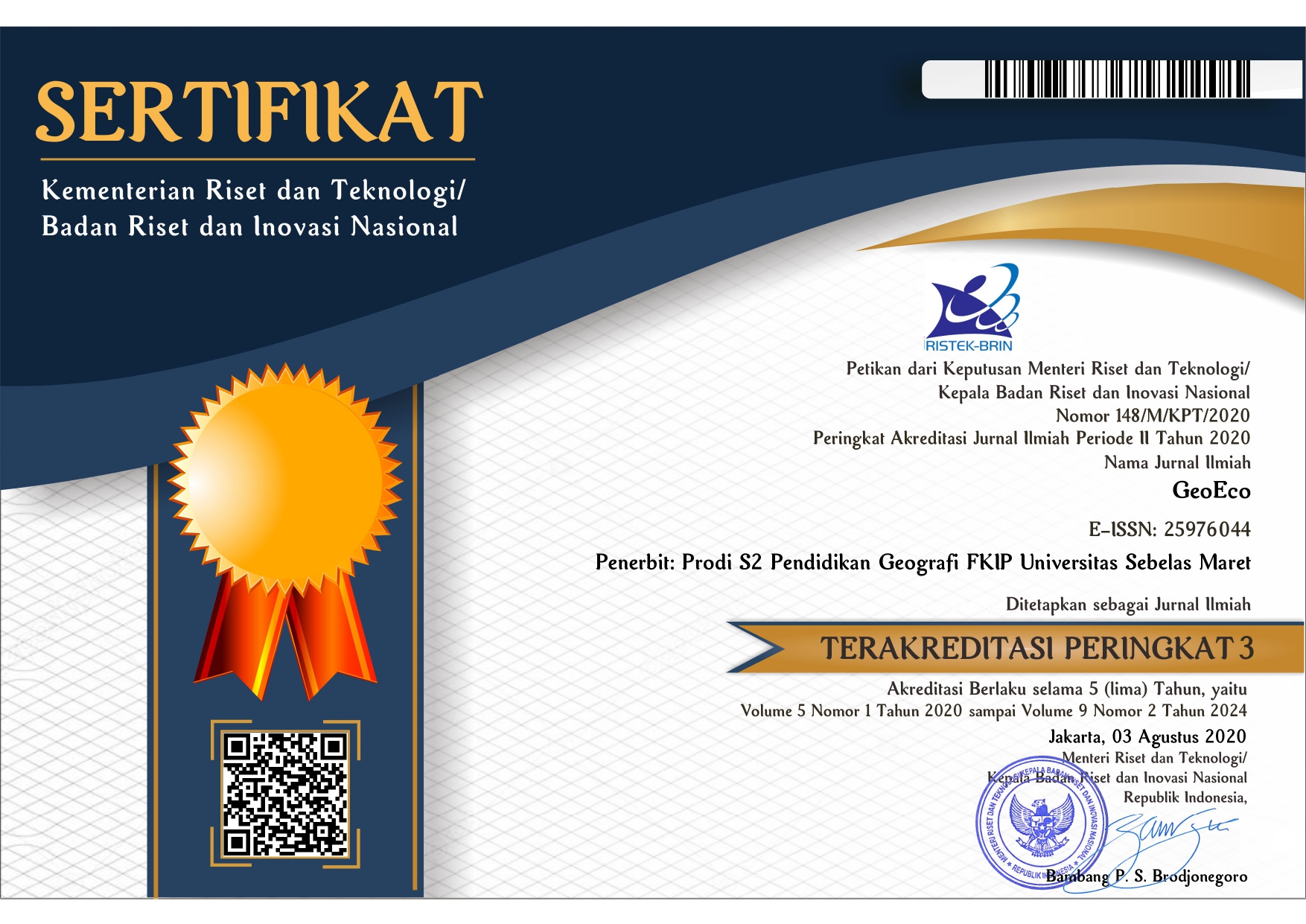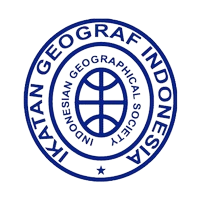SCS-CN MODEL FOR QUANTIFYING SURFACE RUNOFF POTENTIAL IN THE ECOREGION SEGMENTATION OF BANTUL REGENCY
Abstract
Keywords
Full Text:
PDFReferences
Adi, R. N., & Setiawan, O. (2010). Penentuan Zonasi Tataguna Air Tanah di Kabupaten Bantul, Daerah Istimewa Yogyakarta. Jurnal Penelitian Hutan dan Konservasi Alam, 7(4): 315-339. doi: 10.20886/jphka.2010.7.4.315-339
Adji, T. N. (2006). Peranan Geomorfologi dalam Kajian Kerentanan Air Bawah Tanah Karst. Indonesian Cave and Karst Journal, 2(1), 64–74. doi: 10.31227/osf.io/zancv
Appels, W. M., Bogaart, P. W., & van der Zee, S. E. A. T. M. (2017). Feedbacks Between Shallow Groundwater Dynamics and Surface Topography on Runoff Generation in Flat Fields. Water Resources Research, 53(12), 10336–10353. doi: 10.1002/2017WR020727
Asdak, C. (2020). Hidrologi dan Pengelolaan Daerah Aliran Air Sungai: Edisi Revisi Kelima. Yogyakarta: Gadjah Mada University Press.
Borisova, T., Cutillo, M., Beggs, K., & Hoenstine, K. (2020). Addressing the Scarcity of Traditional Water Sources through Investments in Alternative Water Supplies: Case Study from Florida. Water, 12(8), 2089. doi:10.3390/w12082089
David, D. (2016). An Approach to Analysing Plot Scale Infiltration and Runoff Responses to Rainfall of Fluctuating Intensity. Hydrological Processes, 31(1), 191–206. doi: 10.1002/hyp.10990
Erena, S. H. & Worku, H. (2019). Dynamics of Land Use Land Cover and Resulting Surface Runoff Management for Environmental Flood Hazard Mitigation: The Case of Dire Daw City, Ethiopia. Journal of Hydrology: Regional Studies, 22, 1–10. doi: 10.1016/j.ejrh.2019.100598
Haghnazari, F., Shahgholi, H., & Feizi, M. (2015). Factors Affecting the Infiltration of Agricultural Soils: Review. International Journal of Agronomy and Agricultural Research (IJAAR), 6(5), 21–35.
Hemathilake, D. M. K. S & Gunathilake, D. M. C. C. (2022). Agricultural Productivity and Food Supply to Meet Increased Demands. Future Foods: Global Trends, Opportunities, and Sustainability Challenges, 539–553. doi: 10.1016/B978-0-323-91001-9.00016-5
Hidayah, E., Widiarti, W. Y., & Ammarulsyah, A. R. (2022). Zonasi Tingkat Kerawanan Banjir Bandang dengan Sistem Informasi Geografis di Sub-DAS Kaliputih Kabupaten Jember. Jurnal Teknik Pengairan, 13(2), 273–282. doi: 10.21776/ub.pengairan.2022.013.02.12
Hu, S., Fan, Y., & Zhang, T. (2020). Assessing the Effect of Land Use Change on Surface Runoff in a Rapidly Urbanized City: A Case Study of the Central Area of Beijing. Land, 9(1), 17. doi: 10.3390/land9010017
Kang, M., & Yoo, C. (2020). Application of the SCS–CN Method To the Hancheon Basin On The Volcanic Jeju Island, Korea. Water, 12(12), 3350. doi: 10.3390/w12123350
Kim, J., Johnson, L. E., Cifelli, R., Choi, Jeongho., & Chandrasekar, V. (2018). Derivation of Soil Moisture Recovery Relation Using Soil Conservation Service (SCS) Curve Number Method. Water, 10(7), 833. doi: 10.3390/w10070833
Krajewski, A., Sikorska-Senoner, A. E., Hejduk, A., & Hejduk, L. (2020). Variability of the Initial Abstraction Ratio in an Urban and an Agroforested Catchment. Water (Switzerland), 12(2), 1-15. doi: 10.3390/w12020415
Larraz, B., Rubio, N. G., Gamez, M., Sauvage, S., Cakir, R., Raimonet, M., & Perez, J. M. S. (2024). Socio-Economic Indicators for Water Management in the South-West Europe Territory: Sectorial Water Productivity and Intensity in Employment. Water, 16(7), 959. doi: 10.3390/w16070959
McCuen, R. H. (1998). Hydrologic Analysis and Design: 2nd edition. New Jersey, Prentice Hall.
Mohamed E. S., Abdellatif, M. A., Sameh, K. A. E., & Khalil, M. M. N. (2020). Estimation of Surface Runoff Using NRCS Curve Number in Some Areas in Northwest Coast, Egypt. E3S Web of Conferences 167, 02002. doi: 10.1051/e3sconf/202016702002
Motovilov, Y. G., Gottschalk, L., Engeland, K., & Rodhe, A. (1999). Validation of A Distributed Hydrological Model Against Spatial Observations. Agricultural and Forest Meteorology, 98, 257–277. doi: 10.1016/S0168-1923(99)00102-1
Munawir, A., Jauhari A., Kurniawan, M. O., & Muhammad, A. N. (2019). Analisis Akuifer Anggota Batugamping Lam Kabeu-Pidie dengan Metode Porositas Sekunder. Prosiding Seminar Nasional Manajemen Bencana di Era Revolusi Industri 5.0, 10 Agustus 2019, Fakultas Geografi UMP.
Permatasari, R., Arwin, & Natakusumah, D. K. (2017). Pengaruh Perubahan Penggunaan Lahan terhadap Rezim Hidrologi DAS (Studi Kasus: DAS Komering). Jurnal Teknik Sipil, 24(1): 91-98. doi: 10.5614/jts.2017.24.1.11
Prabhu, N., Kumar, T.M., & Inayathulla, M. (2020). Runoff Estimation for Arkavathi Valley, Hebbala Valley, Kc Valley, South Pennar Valley, Vrishabhavathi Valley by Using Soil Conservation Services Curve Number Method (SCS-CN). Water Energy International, 63(2), 57-66.
Pratiknyo, P. (2016). Proyeksi Ketersediaan dan Kebutuhan Air Industri di Kab. Tangerang. Seminar Nasional Kebumian XI, 3-4 November 2016, Fakultas Teknologi Mineral, UPN ”Veteran” Yogyakarta, Yogyakarta.
Shrestha, S., Cui, S., Xu, L., Wang, L., Manadhar, B., & Ding, S. (2021). Impact of Land Use Change Due to Urbanisation on Surface Runoff Using GIS-Based SCS–CN Method: A Case Study of Xiamen City, China. Land, 10(8), 839. doi: 10.3390/land10080839
Sitorus, S. R. P., Mulyani, M., & Panuju, D. R. (2011). Konversi Lahan Pertanian dan Keterkaitannya dengan Kelas Kemampuan Lahan serta Hirarki Wilayah di Kabupaten Bandung Barat. Jurnal Tanah Lingkungan, 13(2), 49-57. doi: 10.29244/jitl.13.2.49-57
Sitterson, J., Knightes, C., Parmar, R., Wolfe, K., Muche, M., & Avant, B. (2018). An Overview of Rainfall-Runoff Model Types. International Congress on Environmental Modelling and Software, 27 Juni 2018, Brigham Young University
Wang, J. J., Ding, J. L., Zhang, Z., & Chen, W. Q. (2017). Improved Algorithm of SCS-CN Model Parameters in Typical Inland River Basin in Central Asia. In IOP Conference Series: Earth and Environmental Science, 57(1), 012051. doi: 10.1088/1755-1315/57/1/012051
Zhao, L., Hou, R., Wu, F., & Keesstra, S. (2018). Effect of Soil Surface Roughness on Infiltration Water, Ponding and Runoff on Tilled Soils Under Rainfall Simulation Experiments. Soil and Tillage Research, 179, 47–53. doi: 10.1016/j.still.2018.01.009
Refbacks
- There are currently no refbacks.












.png)

